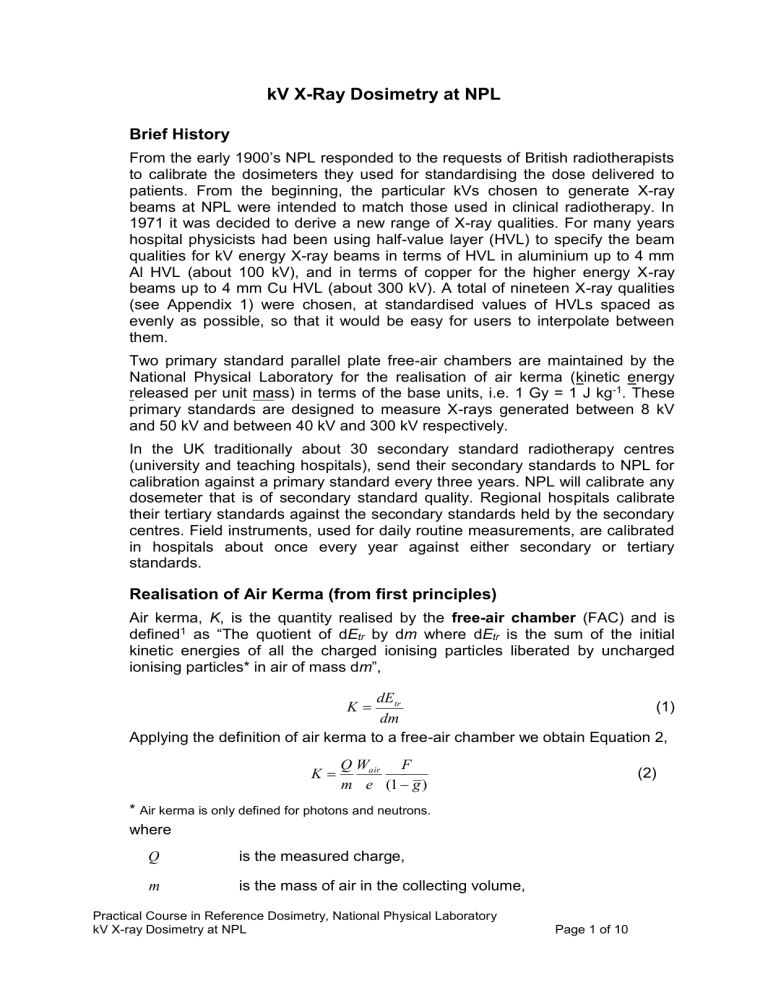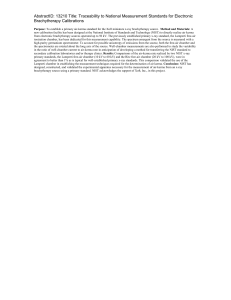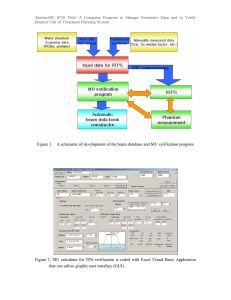kV X-Ray Dosimetry at NPL - National Physical Laboratory

kV X-Ray Dosimetry at NPL
Brief History
From the early 1900’s NPL responded to the requests of British radiotherapists to calibrate the dosimeters they used for standardising the dose delivered to patients. From the beginning, the particular kVs chosen to generate X-ray beams at NPL were intended to match those used in clinical radiotherapy. In
1971 it was decided to derive a new range of X-ray qualities. For many years hospital physicists had been using half-value layer (HVL) to specify the beam qualities for kV energy X-ray beams in terms of HVL in aluminium up to 4 mm
Al HVL (about 100 kV), and in terms of copper for the higher energy X-ray beams up to 4 mm Cu HVL (about 300 kV). A total of nineteen X-ray qualities
(see Appendix 1) were chosen, at standardised values of HVLs spaced as evenly as possible, so that it would be easy for users to interpolate between them.
Two primary standard parallel plate free-air chambers are maintained by the
National Physical Laboratory for the realisation of air kerma (kinetic energy released per unit mass) in terms of the base units, i.e. 1 Gy = 1 J kg -1 . These primary standards are designed to measure X-rays generated between 8 kV and 50 kV and between 40 kV and 300 kV respectively.
In the UK traditionally about 30 secondary standard radiotherapy centres
(university and teaching hospitals), send their secondary standards to NPL for calibration against a primary standard every three years. NPL will calibrate any dosemeter that is of secondary standard quality. Regional hospitals calibrate their tertiary standards against the secondary standards held by the secondary centres. Field instruments, used for daily routine measurements, are calibrated in hospitals about once every year against either secondary or tertiary standards.
Realisation of Air Kerma (from first principles)
Air kerma, K , is the quantity realised by the free-air chamber (FAC) and is defined 1 as “The quotient of d
E tr
by d m where d E tr
is the sum of the initial kinetic energies of all the charged ionising particles liberated by uncharged ionising particles* in air of mass d m ”,
K
dE tr dm
(1)
Applying the definition of air kerma to a free-air chamber we obtain Equation 2,
K
Q m
W air e
F
( 1
g )
(2)
* Air kerma is only defined for photons and neutrons.
where
Q is the measured charge, m is the mass of air in the collecting volume,
Practical Course in Reference Dosimetry, National Physical Laboratory kV X-ray Dosimetry at NPL Page 1 of 10
W air e
F g is the energy required to produce an ion pair in dry air 2
(= 33.97 J/C), is the product of various correction factors (see below) which depend on the design of the free-air chamber and in some cases on the X-ray beam quality and is the fraction of electron energy lost to bremsstrahlung 2
(for kV X-rays generated between 8 kV and 300 kV, g is negligible (=0)).
Aperture of area
X-ray
Defining plane beam
A
Guard electrode
Collecting
volume
Collecting electrode of length l Guard electrode
Guard bars
HT electrode
Figure 1 Main components of the NPL free-air ionisation chamber
(not to scale)
Figure 1 shows a schematic diagram of the NPL free-air chamber. A monodirectional beam of X-rays passes through a defining aperture of accurately known area, A , enters a metal box and passes out through a hole on the far side of the box without striking anything in the box other than the air it contains.
This fulfils the requirement for the realisation of air kerma, i.e. the X-rays interact only with air.
Practical Course in Reference Dosimetry, National Physical Laboratory kV X-ray Dosimetry at NPL Page 2 of 10
The separation of the electrodes in the chamber and its other dimensions are such that secondary electrons released in the collecting volume lose all their energy before they can reach the electrodes or chamber walls. This ensures that the electrons are completely stopped by air. A high potential difference
(field strength of the order of 100 V/cm) maintained between the high-voltage electrode and the collecting electrode sweeps the ions of one sign produced between the dotted lines (see Figure 1) to the collecting electrode. The effective length, l , of the collecting electrode is the actual length of the collecting electrode, l col
, plus half the width of the two gaps to the adjacent earthed guard electrodes. A system of guard bars, to which graded electrical potentials are applied, together with the guard electrodes, ensures that the field lines between the collecting electrode and the high voltage electrode are parallel to each other and perpendicular to the surface of the electrodes.
The actual collecting volume (see Figure 1, dark grey area) varies with the distance between the FAC and the focal spot of the X-ray tube. Because of the difficulty of measuring the actual collecting volume, the defining plane of the
FAC is moved from the centre of the collecting electrode to the front face aperture. It may not be immediately obvious why this is legitimate. After all, the charge we measure with the FAC is produced in the collecting volume and not at the aperture. However, mathematically it can be shown that the charge collected by a free-air chamber is a measure of the exposure at the defining plane of the aperture provided the air attenuation correction is applied.
We will now derive an expression for the total charge, Q , produced within the collecting volume.
Aperture of area A
Focal spot d
1 d
2 dl
Figure 2 Free-air ionisation chamber l
Air kerma, K , is proportional to the charge produced per unit mass ( Q/m ), also called exposure, X (see Equation 2).
Let aperture area = A ,
exposure at aperture = X
1
,
distance from focal spot to aperture = d
1
,
thickness of infinitesimal volume element within collecting volume = dl ,
cross-sectional area of element dl = A
2
,
exposure at element dl = X
2
,
Practical Course in Reference Dosimetry, National Physical Laboratory kV X-ray Dosimetry at NPL Page 3 of 10
distance from focal spot to element dl within collecting volume = d
2
,
charge collected by element dl = dQ ,
charge collected by whole collecting electrode = Q ,
air density =
and
air attenuation correction = f aac
.
The charge collected by element dl is dQ
X
2
A
2
dl . (3)
mass of air in element dl
A
2
A
d
2 d
1
2
(4)
A in creases with increasing
2 d (inverse square law).
2
X
2
X
1 f aac
d d
2
1
2
(5)
X
2 de creases with increasing d
2
(inverse square law).
By combining (3), (4) and (5) we get: dQ
X
1 f aac
d d
2
1
2
A
d
2 d
1
2
dl . (6)
The total charge, Q , produced within the collecting volume can be calculated by integration:
Q
0 dQ
l
0
X
1 f aac
A
dl . (7)
From Equation 7 follows:
Q
X
1 f aac
A
l . (8)
It is interesting to see that the collecting volume of a free-air chamber is defined by the aperture area, A , and the effective length, l , of the collecting electrode which can both be measured. The volume then becomes Al , and the mass of air within this volume is m = Al
, where
is the air density 3,4 at a pressure of
101.325 kPa, a temperature of 20ºC and 50% relative humidity.
From Equation 8 we can also see that the charge, Q , collected by a FAC is a measure of the exposure at the defining plane of the front face aperture, X
1
, corrected for air attenuation ( f ). aac
Practical Course in Reference Dosimetry, National Physical Laboratory kV X-ray Dosimetry at NPL Page 4 of 10
The Free-Air Chamber Correction Factors
The total correction factor ( F ) (see Equation 2) is the product of several correction factors, which are listed below.
Some of the ions, which are produced in the collecting volume of the free-air chamber, are lost by ion recombination before they reach the collecting electrode and this correction is determined by experiment.
Correction for the air attenuation between the aperture and the collecting electrode is necessary because the reference point of the chamber is taken to be the defining plane of the aperture and not the centre of the collector.
A field distortion correction is necessary because the electric field inside the free-air chamber is not perfectly perpendicular to the electrodes at all points.
This is despite the presence of the guard bars, which only reduce the distortion effect.
Correction for the front face penetration is necessary if the front face of the free-air chamber is not thick enough to attenuate the X-ray beam. It is more important with large beam sizes and high energy beams.
An HT polarity correction is necessary because the measured charge can depend on the polarity of the HT supply. The potential is negative for routine measurements. A correction of half the difference between measurements with positive and negative polarity is applied.
A correction has to be made for photons which are scattered from the main beam through the chamber and which produce ionisation in the space between the electrodes not defined by the ionisation volume. This was measured by surrounding the X-ray beam through the chamber as closely as possible with a plastic cone of sufficient thickness to stop the secondary electrons produced by interactions in the collecting volume. This allows the scattered photons to pass with minimum attenuation and the contribution of these photons to the total ionisation can therefore be measured.
An ion loss correction is necessary at higher energies when the plate separation is less than the range of the secondary electrons in air. It has been calculated using Monte Carlo techniques.
A correction for humidity is applied in accordance with the recommendation of
CCEMRI 5 .
How a Secondary Standard Ionisation Chamber is Calibrated against the
NPL primary standard free-air chamber(s)
A transmission monitor chamber is used to correct all measurements for any variations in X-ray tube output. At the beginning of each measuring cycle
(shutter closed, electrometer unearthed) a pre-exposure leakage current is measured for typically 15 s. Then the shutter opens and the ionisation current is measured for an exposure time of, say, 30 s. The shutter closes, however, the electrometer stays unearthed. Finally, the post
–exposure leakage current is measured for another 15 s, after which the electrometer will be earthed before the next measuring cycle starts.
Practical Course in Reference Dosimetry, National Physical Laboratory kV X-ray Dosimetry at NPL Page 5 of 10
9.5
9.0
8.5
a) b) c) d) e)
First, the ionisation current is measured using the primary standard
FAC.
Next, the secondary standard ionisation chamber is moved into the Xray beam (same position as the primary standard, i.e the reference plane of the secondary standard is identical with the defining plane of the FAC) and the ionisation current is measured.
Finally, another primary standard measurement will be carried out.
Now the mean ionisation current for the primary standard can be determined and a temperature and pressure correction is applied to the standard to monitor response.
A standard to monitor ratio, corrected for temperature and pressure, is also calculated for the secondary standard. f) The calibration coefficient of the secondary standard in terms of Gy/C is the ratio of the primary standard response to the secondary standard response multiplied by the primary standard sensitivity (in terms of
Gy/C) for the particular X-ray quality used during the calibration.
A typical calibration curve for a NE 2561 chamber is shown in Figure 3.
Air kerma calibration coefficient
(corrected to 20 °C, 1013.25 mbar (101.325 kPa) and 50% RH)
10.0
8.0
1.0
3.0
10.0
Half value layer, mm Al
30.0
Figure 3 A typical calibration curve for a NE 2561 ionisation chamber
Practical Course in Reference Dosimetry, National Physical Laboratory kV X-ray Dosimetry at NPL Page 6 of 10
References
1.
2.
ICRU(1980); International Commission on Radiological Units and
Measurement, Radiation Quantities and Units. ICRU Report 33 .
CCEMRI 1985 report of the 8 th meeting of section I (Rayons X et
,
électrons). Comité Consultatif pour les Étalons de Mesure des
Rayonnements Ionisants, Rapport de la 11 ème session (Sèvres: BIPM)
R157-166.
3.
4.
Giacomo, P; Equation for the determination of the Density of Moist Air
(1981). Metrologia 18 , 33-40, (1982)
Davis, R S; Equation for the determination of the Density of Moist Air
(1981/91). Metrologia 29 , 67-70, (1992)
5. Correction d’Humidité Report of the 4th meeting of Section I (Rayons X et
, électrons). Comité Consultatif pour les Étalons de Mesure des
Rayonnements Ionisants, Rapport de la 4 ème Réunion - 1977 pageR(I)6. Bureau International des Poids et Mesures (BIPM),
Sèvres,1977.
Practical Course in Reference Dosimetry, National Physical Laboratory kV X-ray Dosimetry at NPL Page 7 of 10
Appendix 1
X-ray qualities used for therapy-level exposure and air kerma calibrations at NPL
Quality Half- value layer
Generating potential
Added filter
Approximate air kerma rate mm Al kV mm Al Gy/min Reference number
2.4.1
2.4.2
2.4.3
2.4.4
2.4.5
2.4.6
2.4.7
2.4.8
2.4.9
2.4.10
2.4.11
0.024
0.036
0.050
0.070
0.10
0.15
0.25
0.35
0.50
0.70
1.00
8.5
10
11.5
14
16
20
24
34
41
44
50
None
0.025
0.050
0.11
0.20
0.30
0.45
0.47
0.56
0.74
1.01
0.08
0.13
0.17
0.18
0.18
0.22
0.21
0.39
0.43
0.40
0.33
Table A1.1
Therapy-level very-low energy X-rays, 0.035-1.0 mm Al HVL.
Thin-window ionisation chambers (PTW 23344 and PTW 23342)
Inherent filtration 1 mm Be
Focus-chamber distance 0.5 m
Quality Half-value layer mm Al mm Cu
Generating potential kV
Added filtration mm Cu mm Al Reference number
2.2.1
2.2.2
1.0
2.0
0.030
0.062
50
70
0.75
1.6
2.2.3
2.2.4
4.0
5.0
0.150
0.200
100
105 0.1
3.4
1.0
Table A1.2
Therapy-level low energy X-rays, 1.0-8 mm Al HVL.
Secondary standard thimble chamber
Inherent filtration 2.5 mm Be + 4.8 mm Perspex
Focus-chamber distance 0.75 m
Practical Course in Reference Dosimetry, National Physical Laboratory kV X-ray Dosimetry at NPL Page 8 of 10
Quality
Reference number
Half-value layer mm
Al mm
Cu
Generating potential kV mm
Sn
(a) Inherent filtration 2.5 mm Be + 4.8 mm Perspex
2.2.6 12.3 1.0 180
Added filtration mm
Cu
2.2.5 8.8 0.50 135 0.27
(b) Inherent filtration 4 mm Al equivalent + 4.8 mm Perspex
0.42 mm
Al
1.0
1.0
2.2.7
2.2.8
Table A1.3
16.1 2.0
20.0 4.0
220
280 1.4
1.20
0.25
Therapy-level medium energy X-rays, 0.5-4 mm Cu HVL.
Secondary standard thimble chamber
Focus-chamber distance 0.75 m
1.0
1.0
Practical Course in Reference Dosimetry, National Physical Laboratory kV X-ray Dosimetry at NPL Page 9 of 10
Appendix 2
Definitions
Primary standard: An instrument of the highest metrological quality that permits determination of the unit of a quantity from its definition, and the accuracy of which has been verified by comparison with the comparable standards of other institutions participating in the international measurement system. A primary standard is usually a one-off instrument. Our primary standards were designed by the NPL workshop in consultation with the physicists at NPL.
Secondary standard: An instrument of secondary standard quality that has been calibrated by comparison with a primary standard.
Temperature and Pressure correction factor: The calibration factors reported in the NPL certificate apply when the chamber is used in ambient atmospheric conditions of 20 o C, 1013.25 mbar (101.325 kPa) and 50% relative humidity (standard conditions). For accurate measurements it is therefore necessary to correct for any differences between the air density in the chamber at the time of measurement and that for which the calibration factor applies using: k
T , P
( 273 .
15
T )
293 .
15
1013 .
25
P
Where:
T
P is the ambient temperature in o C and is the ambient atmospheric pressure in mbar.
Tertiary standard: An instrument calibrated by direct comparison with a secondary standard.
Field instrument: A measuring instrument used for routine measurements (i.e. for daily QA measurements in a radiotherapy department).
Standard deviation of the mean (SDOM):
SDOM
n
1 x
n
100
Where:
n
1 is the standard deviation of n readings, x n is the mean of n readings and is the number of readings.
Practical Course in Reference Dosimetry, National Physical Laboratory kV X-ray Dosimetry at NPL Page 10 of 10

